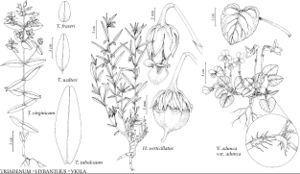Difference between revisions of "Hybanthus verticillatus"
Hist. Pl. 4: 344. 1873.
FNA>Volume Importer |
imported>Volume Importer |
||
| (5 intermediate revisions by 2 users not shown) | |||
| Line 10: | Line 10: | ||
|special_status={{Treatment/ID/Special_status | |special_status={{Treatment/ID/Special_status | ||
|code=F | |code=F | ||
| − | |label= | + | |label=Illustrated |
}} | }} | ||
| − | |basionyms={{Treatment/ID/ | + | |basionyms={{Treatment/ID/Basionym |
|name=Viola verticillata | |name=Viola verticillata | ||
|authority=Ortega | |authority=Ortega | ||
| + | |rank=species | ||
| + | |publication_title=Nov. Pl. Descr. Dec. | ||
| + | |publication_place=4: 50. 1797 | ||
}} | }} | ||
|synonyms={{Treatment/ID/Synonym | |synonyms={{Treatment/ID/Synonym | ||
|name=Hybanthus verticillatus var. platyphyllus | |name=Hybanthus verticillatus var. platyphyllus | ||
|authority=(A. Gray) Cory & H. B. Parks | |authority=(A. Gray) Cory & H. B. Parks | ||
| + | |rank=variety | ||
}} | }} | ||
|hierarchy=Violaceae;Hybanthus;Hybanthus verticillatus | |hierarchy=Violaceae;Hybanthus;Hybanthus verticillatus | ||
| Line 42: | Line 46: | ||
-->{{#Taxon: | -->{{#Taxon: | ||
name=Hybanthus verticillatus | name=Hybanthus verticillatus | ||
| − | |||
|authority=(Ortega) Baillon | |authority=(Ortega) Baillon | ||
|rank=species | |rank=species | ||
| Line 56: | Line 59: | ||
|publication title=Hist. Pl. | |publication title=Hist. Pl. | ||
|publication year=1873 | |publication year=1873 | ||
| − | |special status= | + | |special status=Illustrated |
| − | |source xml=https:// | + | |source xml=https://bitbucket.org/aafc-mbb/fna-data-curation/src/2e0870ddd59836b60bcf96646a41e87ea5a5943a/coarse_grained_fna_xml/V6/V6_192.xml |
|genus=Hybanthus | |genus=Hybanthus | ||
|species=Hybanthus verticillatus | |species=Hybanthus verticillatus | ||
Latest revision as of 22:19, 5 November 2020
Plants subshrubs, perennial, 10–40 cm, from ligneous rhizome. Stems 1–20, clustered, erect, simple or branched from proximal nodes, glabrous or strigose to pilose. Leaves: proximal opposite or subopposite, distal usually alternate, petiolate or sessile; stipules linear-subulate and minute to leaflike, 3–40 mm, glabrous or hirsute, gland-tipped; petiole 0–1 mm; blade linear, narrowly elliptic, lanceolate, or oblanceolate, 1–5.5(–6) × 0.1–0.8(–1.1) cm, base attenuate, margins usually entire, ciliate or eciliate, apex acute to acuminate, surfaces glabrous, strigose, or pilose. Inflorescences 1-flowered; peduncle usually pendant at anthesis, sometimes horizontal or erect, usually pendant in fruit, 3–14 mm, hirsute to densely puberulent, occasionally glabrous on segment distal to joint; bracteoles present. Flowers: sepals appressed to corolla, ovate to lanceolate, margins ciliate or eciliate, apex acute; petals: upper greenish white, cream, or yellowish, with purple tips, oblong, 2–2.5 mm, apex acute to rounded, glabrous; laterals similar to upper except 3 mm; lowest greenish white, cream, or yellowish, sometimes tinged purplish, 2.5–6 mm, claw 2–3 × 0.5 mm, distal limb broadly ovate to orbiculate, ± concave at anthesis, 1–3 mm wide, apex rounded to obtusely angled, adaxial surface usually bearded basally and on claw; presence of cleistogamous flowers not determined. Capsules ovoid to globose, 4–7 mm. Seeds 6, dark brown to shiny black, subglobose, ± flattened with angular edges, or broadly ovoid, 1.8–2.5(–3) mm. 2n = 16, 24, 32.
Phenology: Flowering Apr–Oct.
Habitat: Dry plains, gravelly soil in prairies, mesas, fields, desert grasslands, pinyon-juniper woodlands, chaparral, rocky slopes, forest edges, oak and mesquite savannahs, riparian habitats
Elevation: 10–2100 m
Distribution

Ariz., Colo., Kans., N.Mex., Okla., Tex., Mexico (Chihuahua, Coahuila, Sonora).
Discussion
Selected References
None.
